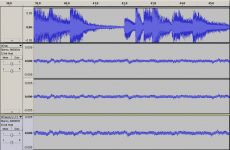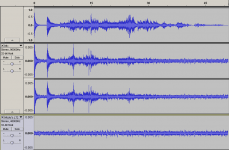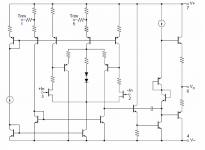This sorting out of what's going on in the time domain is getting interesting ... George's DiffMaker files at first glance look impossibly good, so what's going on? OK, have a closer look at samples B and D ...
Using Audacity again, I oversample, shift to align, invert and subtract - and get lots of muck ... very different from George's file of B-D. But, then have a closer look towards the end of the two difference files, and get this:

What DiffMaker got towards the end of the file is at bottom - just inverted here; what Audacity produced is above - identical!! So, DiffMaker is doing nothing fancy here. But, the real file, right channel of sample D, is above again - and nominally the difference looks good ... but look again: if we ignore the transient strikes of the piano, and just look at the decay areas then there is only 20dB of difference at those points(!) - highly likely to be easily audible ...
But is that what is really happening? ... methinks a bit more scrounging around is necessary ...
Using Audacity again, I oversample, shift to align, invert and subtract - and get lots of muck ... very different from George's file of B-D. But, then have a closer look towards the end of the two difference files, and get this:

What DiffMaker got towards the end of the file is at bottom - just inverted here; what Audacity produced is above - identical!! So, DiffMaker is doing nothing fancy here. But, the real file, right channel of sample D, is above again - and nominally the difference looks good ... but look again: if we ignore the transient strikes of the piano, and just look at the decay areas then there is only 20dB of difference at those points(!) - highly likely to be easily audible ...
But is that what is really happening? ... methinks a bit more scrounging around is necessary ...
Last edited:
That makes it OK.
My worse was separating frozen ravioli with a razor sharp paring knife while holding them in one hand.
Kinda like my Mech Tech friend holding a block of metal in one hand while drilling a hole in it with a power drill. You know what happened. yes. he drilled a hole into his hand. That must have hurt.
-RNM
Last edited:
Both Douglas Self and Samuel Groner measured the OPA604. Here are comments by Samuel Groner:
SG-Acoustics · Samuel Groner · IC OpAmps
opamp_distortion.pdf file
We have tested this opamp, about 13 years ago, for sound. Some people liked it, but it definitely did not sound accurate.
Interesting. Some years ago, I too was attracted by the high power supply
voltage and the jfets and folded cascode, but I could not make it sound
satisfactory, and as you know, it's not because I object to a modest
amount of distortion per se.
This sorting out of what's going on in the time domain is getting interesting ... George's DiffMaker files at first glance look impossibly good, so what's going on? OK, have a closer look at samples B and D ...
Using Audacity again, I oversample, shift to align, invert and subtract - and get lots of muck ... very different from George's file of B-D. But, then have a closer look towards the end of the two difference files, and get this:
View attachment 446672
What DiffMaker got towards the end of the file is at bottom - just inverted here; what Audacity produced is above - identical!! So, DiffMaker is doing nothing fancy here. But, the real file, right channel of sample D, is above again - and nominally the difference looks good ... but look again: if we ignore the transient strikes of the piano, and just look at the decay areas then there is only 20dB of difference at those points(!) - highly likely to be easily audible ...
But is that what is really happening? ... methinks a bit more scrounging around is necessary ...
The playback/recording process become key to this. Is the DAC and the ADC sharing the same clock? Is there some time/phase shift between them that could be significant? Many soundcards are not really too benign on these issues and you could also be looking at a sample rate converter operating in the background messing with all the data.
If you sample rate convert the data you are really testing the sample rate converter not the source data.
Diffmaker has some stuff in it to align data that has time shifts in it. Audacty is pretty simpleminded by comparison.
Going down this route I would start with a digital loopback at the sound interface to validate it.
If the source data rate is asynchronous to the ADC sample rate you could find a lot of odd things that are artifacts but probably not real in-band stuff. This is why sample rate converters are hard to design.
Harmonic structure ??
I do not think so.
Diffmaker has some stuff in it to align data that has time shifts in it. Audacty is pretty simpleminded by comparison.
Audacity is a free tool ....., results are corresponding.
If you pre-prepare data for Diffmaker in a more sophisticated software, like AA, Diffmaker will give even better result than when used as the only tool.
I liked this part, in 1990's, for instrumentation purposes. It had 100V/us SR and 0.0006%/100kHz/3V/200 ohm. I have never tried it for audio, unfortunately. Now it is discontinued.
Quiescent current was 15mA, at 2 x 15V supply.
Quiescent current was 15mA, at 2 x 15V supply.
Attachments
Last edited:
I would say that what these artifacts are, is the distortion occurring on some of the original files during the fast rising peaks of music. This distortion doesn't cancel when the file is subtracted from another file, thus at these points new spectra content appears in the diff file.
Thanks George.
You are way ahead of me in using software to analyse results. Is it possible that the AD convertor is getting caught out by these transients do you think.
I wonder if two identical but separate recordings of that piece would show the same anomaly or whether they would resolve to a true null when subtracted.
LF411's could be very noisy. Trust me, I have a bunch that I took out of Vendetta Servos.
I moved on the the AD711 and it was consistently quieter, and better overall.
Exactly so, John, as I found out. The odd thing is, some were very noisy, but others were quite a bit better. It's either inconsistency in manufacture, which I am going to believe easily since Nat Semi has been at it for ages, or the number of duds has grown out of any proportion.
I found out only when one of them refused to work, so I threw in a TL071, it worked as is and there was considerably less noise to be seen and heard. This tehn started me off on the TL0 series; they have modest specs and are almost firt cheap, yet they can deliver a very reasonable perofmence with a discrete current stage added. Certainly no audio dedicated chip, but much better than one would expect from a part so cheap. Perhaps we are fooled by the inverse price function, you know, it's so cheap it's got to be bad.
Interesting. Some years ago, I too was attracted by the high power supply
voltage and the jfets and folded cascode, but I could not make it sound
satisfactory, and as you know, it's not because I object to a modest
amount of distortion per se.

Nelson, would you mind telling what you faulted it for enough to discard it?
I objected to its false warmth, it sounded artifical to me. On my n-th attempt, I did manage to cool it of a bit, but overall it still irritated me after 2 hours of listening. When a hard wooden stick strikes a brass plate tutta forza, I exect to hear some sting - and it gave me a polished and sort of rounded off sound lacking the sting. OP 37 never missed a beat.
I liked this part, in 1990's, for instrumentation purposes. It had 100V/us SR and 0.0006%/100kHz/3V/200 ohm. I have never tried it for audio, unfortunately. Now it is discontinued.
Quiescent current was 15mA, at 2 x 15V supply.
And the mystery part is ... ?
Yes, this is what needs to be done ... several recordings with absolutely nothing changing, but start times - how consistent are the recordings, do any patterns in variation of behaviour emerge?I wonder if two identical but separate recordings of that piece would show the same anomaly or whether they would resolve to a true null when subtracted.
If one starts to pre-process the data so DiffMaker doesn't choke, or produce weird results - the software certainly fails to make sense of things if one deliberately distorts a version in a consistent way; I've done this a couple of times, and the fact that the program completely failed to extricate what I had done means that I would never take what it showed seriously - then could one be undistorting the very thing that is key to the subjectively significant differences?
Time shifts within might make sense, except for the fact that I brickwalled out everything below 10kHz, and compared the remanent waveforms at a number of points where high amplitude signal occurred, at beginning, middle, and end of files - the two versions synch'd perfectly, to easily a tenth of a sample width.
I'm going to do another round, looking at where DiffMaker seems to be doing major fudging, and see if I can work what it did, and whether that makes sense ...
Yes, this is what needs to be done ... several recordings with absolutely nothing changing, but start times - how consistent are the recordings, do any patterns in variation of behaviour emerge?
I might do that later if anyone wants a go at spotting differences. Same piano track, say first 30 seconds or so.
the value of my stash
Maybe the two stooges (Steve Jeffery & Randy Patton) are still interested.
- Status
- Not open for further replies.
- Home
- Member Areas
- The Lounge
- John Curl's Blowtorch preamplifier part II

